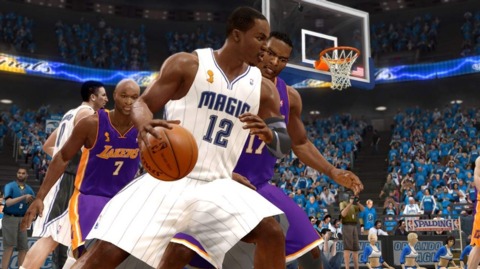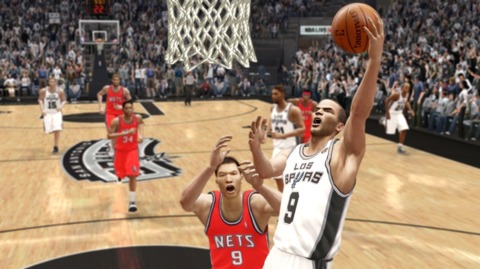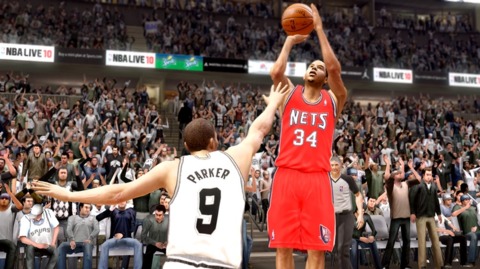NBA Live 10: Changing the Game
"We're moving away from spreadsheet ratings… that's 'videogame speak.' All the stuff we've done [with NBA Live 10], that's what I want to see driving player ratings."- NBA Live producer Sean O'BrienThere's a little revolution brewing up in the NBA Live...

"We're moving away from spreadsheet ratings… that's 'videogame speak.' All the stuff we've done [with NBA Live 10], that's what I want to see driving player ratings."
There's a little revolution brewing up in the NBA Live franchise, one that I think is going to change the way sports videogames are made… once the rest of the world catches up, that is. There's plenty that's new happening with this year's NBA Live 10--as I saw earlier this week when EA Sports producers came by to show off the game. I'll get to the big changes in Live, but I'd like to start with an aspect of the game that I think might turn out to be the most significant change to how sports games are going to be made in the coming years, and it has to do with player ratings.
The Ratings Game
Player ratings are always a hot topic in sports games. Whether it's arguing about the relative ratings of Michael Vick and Brett Favre as they return to Madden NFL 10, or discussing where you think Florida quarterback Tim Tebow should be rated in this year's NCAA Football 10, it's a constant back-and-forth, one that is reflected in sports games via frequent roster updates. But, like so much else in sports, there's an element of bias in player ratings that is sometimes difficult to reconcile with the facts. In some cases the bias is overt--as might be the case in the Vick or Favre debates, where fan controversy stokes the fires. But even in situations where player performance and statistics drives the ratings decisions--as is the case with the sports game developers at companies like EA Sports and 2K Sports who assign the ratings to players--the simple fact of the matter is that, at its core, an attribute rating is often a judgment call.
That is set to change, and NBA Live is leading the way. That's because more and more of the player data in NBA Live is being driven directly by the so-called Dynamic DNA system, which was introduced in 2008's NBA Live 09. Dynamic DNA takes the metric ton of data recorded by the Synergy scouting service (who partners with EA Sports in this feature) and feeds it directly into Live. As a result, if you're playing Live, you have a direct feed as to what is happening with every player and every team in the NBA, thanks to the daily downloads available in the game.
According to producers, the NBA Live team barely scratched the surface of what Dynamic DNA could do with NBA Live 09. This time around, the data being pulled into the game has been expanded--with more categories of stats being used--and that data will surface in the game in a slightly different way. Most importantly to me, though, is the process of how the Live team is handling their player ratings.
This year, the Synergy data has an extreme focus on shooting tendencies for players. Bring up a player's DNA data and you'll see a level of shooting detail that breaks down his entire offensive game--not based on an arbitrary rating assigned to him, but from actual on-court percentages.
Here's some of the information on the Lakers' Kobe Bryant, pulled from the DNA Scouting Report in the NBA Live 10 demo:
Scoring Tendencies
25% At the Basket
56% Jump Shots
19% Post-UpsPerimeter Tendencies
33% Drive Left
46% Pulls Up
53% Finish at the Basket
33% Drives Right
46% Pulls Up
54% Finish at the Basket
34% No-Dribble JumperPost Tendencies
43% Turn Left
43% Turn Right
14% Faceup
Jump Shots Overall
42% Jump Shots[Jump Shot] Range Breakdown
46% Short
43% Mid-Range
37% 3 Point Shots[Jump Shot] Situation Breakdown
50% No Dribble Unguarded
37% No Dribble Guarded
43% Off-Dribble
From these percentages, you can derive a fairly sophisticated picture of Kobe's offensive game--and, when compared to DNA data in the past, a detailed account of how Bryant's game has changed over the years. It's this kind of data that is driving a good chunk of Bryant's actual player ratings in NBA Live 10. Producers told me that approximately 70 percent of NBA Live 10's player ratings are determined by Synergy data, and t hat number is expected to only increase in coming years.
"The goal is to have all player ratings driven by actual Synergy data," game producer Sean O'Brien told me. "We're moving away from spreadsheet ratings… that's 'videogame speak.' All the stuff we've done [with NBA Live 10], that's what I want to see driving player ratings."
While the focus for DNA is on offense this year, already the team is planning for next year: they're working with Synergy to develop and import a host of new defensive stats into next year's game, making the ratings of players in next year's NBA Live 11 that much more complete.
While the idea of having player ratings driven by hard numbers is an enticing one, it's obvious that this kind of extensive data has a value all its own. EA has already trumpeted the Dynamic DNA service as a scouting service for NBA teams--and if the feature expands as it looks like it will, it's practically inevitable that EA will find a way to monetize it as a premium service. They've already done something very similar, in fact, with last year's FIFA 09; the Adidas Live Season featured on-the-fly roster updates that were free for one league of the player's choice, if you wanted data from additional leagues, you had to pay for it.
It seems just a matter of time before players are paying for the privilege of keeping up with the NBA via Dynamic DNA.
NBA… Courtside
While Dynamic DNA is driving so much under NBA Live 10's hood, it isn't the whole story. The team behind the Live's gameplay are quick to own up to the mistakes of previous Live games, yet quick to focus on what's been improved for NBA Live 10. Controls are first and foremost--in addition to tweaks made to well-received features like last year's pick and roll controls, there's some new additions to gameplay specifically designed to let advanced Live players get more out of their team. The goal, producers told me, is to get the player thinking about playing all over the court--not just looking for the dunk or the three-pointer.
First up are "solution layups", which gives you more control when driving towards the basket to drop one in. When you get close to the hoop, you can go either to the left or the right of the basket by pressing the left stick in the correct direction and pressing the shoot button. These solution layups are great for advanced Live players who are looking to beat defenders on either side of the basket. For certain skilled players in the game--such as nimble guards like Steve Nash or Manu Ginobli--you'll have access to specific moves designed to help you get around that first defender--by holding down the right trigger and moving the left stick you'll be able to beat your defender with specialized moves like the pro step layup, Euro step layup, and the spin layup.
You've got several options for passing in NBA Live 10--in addition to icon passing, which is pulled off by holding the left trigger and then choosing the corresponding icon of the player you wish to pass to, you've also got options like freestyle passing. Freestyle passes are controlled by holding down the left stick and moving the right stick in any direction. The direction you move the right stick will determine which direction you pass the ball.
The new direct pass receiver control is a big help for players looking to get their CPU teammates into position on the floor, without having to always call a set play. To do so, you hold the left trigger and the button of the player you wish to pass to. With that button held down, you now have complete control over where that player moves on the court--and releasing the player button will cause your original player to pass the ball. In theory it sounds tough but, in practice based on my time with the game, it's a pretty easy way to create some space, or get a player driving to the basket where they otherwise might not. A similar control feature allows you to control an off-ball player without throwing a pass, in essence creating a temporary player lock. To do so, you once again hold down the left trigger and press the button of the player you wish to control. Once you've switched player, you let go of the left trigger while still holding your teammate's button. Once you let go of the button, you'll be locked into an offball player and can do things like call off ball screens to help get that player free in order to set up an easy play.
The one-on-one battles between NBA stars is why so many of the leagues fans love it and, knowing this, the developers are looking to make those battles more prevalent in the game as well. To that end, size-up moves (a series of fancy dribbles that is executed with the right trigger/R2 during a stationary dribble) can help you break down an opposing defender. The longer you hold it, the better chance you have of breaking his ankles once you decide to move--and there are also attacking size up moves you can do by mixing in the right stick with the right trigger held. In an attempt at balance, using size-up dribbles for too long and your defender will have window in which he can snatch the ball out of your hands.
NBA Live 10 is also utilizing some of the ideas from last year's NCAA Basketball 09, including the post moves down low as well as that game's "team tempo" feature. While the team tempo variables aren't brought to the surface via the HUD as they were in NCAA 09, it sounds like they will work in a similar way, in that you'll need to play your team the correct way or else your team's abilities will suffer. Coupling team tendencies with the advanced player statistics available to players via the Dynamic DNA, as well as a ton of team-specific sets available in the game, and it seems like knowing your team and its players will pay off bigger dividends than ever before NBA Live 10.
Most of my demo focused on the full version NBA Live 10, including details a big feature that I can't talk about just yet, but EA also left code of the Live 10 demo that will be released in the coming weeks. The demo features a two-quarter match-up (four minutes apiece) between last year's NBA Finalists, the Orlando Magic and the Los Angeles Lakers. Things that are immediately noticeable in the demo, beyond some of the new gameplay mechanics described above include better body-to-body contact between players, ball physics that make sense more often than not (something I could rarely claim in previous versions of Live) and busier CPU teammates on the floor. Of course, it all remains to be seen for the full version of NBA Live 10 but, at least from the demo, things seem to be looking up.
Baseline
In the short-term, I think NBA Live 10 holds a good deal of promise--the game looks better and the developers seem dead-set on making the gameplay is improved as well. However, it's the long-term impact of NBA Live's approach to game development and player progression that intrigues me the most. Player ratings based on a constant stream of hard data rather than subjective judgment have been a long time coming and it's clear that--should the Live team figure out a way to integrate Synergy's exhaustive NBA data into the game's ever-improving AI--the future of sports gaming will take another leap forward.
Look for much more on NBA Live 10 in the coming weeks ahead of the game's October 6 release.
Got a news tip or want to contact us directly? Email news@gamespot.com


Join the conversation